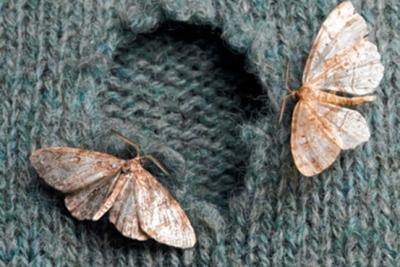Shrieks of horror can be heard across the country as people finally succumb to the Autumn weather and dig out their warm woollies and coveted cashmere. This is when householders discover that while their precious pashminas were stored away they were providing a summer time feast for the dreaded clothes moth or Tineola bisselliella.
Left untreated, moths can do massive damage to any natural fabrics such as wool carpets and rugs. Managing Director of Cleankill Pest Control Paul Bates says moth problems are on the increase: “I’ve been working in the pest control industry for nearly three decades and the moth activity is definitely on the increase. Part of the problem in recent years has been a combination of the withdrawal of some of the most effective insecticides, such as Dichlorvos, and the return to fashion of many natural fibre clothes, such as cashmere which is a favourite foodstuff of the clothes moth.”
People can identify adult textile moths – which are micro moths and quite similar to the stored product moths that are sometimes found in dry foodstuffs in kitchens – as they will often be seen running rather than flying. They are unlike the common garden moths that will come in and fly towards lights and windows. Their favourite diet is the detritus found at the bottom of birds’ nests – a rich source of protein – but they are equally at home in the bottom of a chest of drawers, the darker, warmer and dirtier the better. Paul advises people to be careful when storing winter woollies. Clothes should be hot washed or dry cleaned prior to being put away and clothes, drawers and wardrobes should be checked before winter storage.
He explains: “There are good quality storage bags available from department stores such as John Lewis http://www.johnlewis.com/vacuum-bag-storage-set-small-medium/p164765?nav... which clothing is put into – the air is then sucked out using a standard vacuum cleaner hose – these bags give a good level of protection against moth infestation. If bagging is not possible then clothing in drawers should be turned over and moved at least once a month as the moths dislike disturbance and light.” If all preventive measures have failed, then a company such as Cleankill can apply insecticidal treatments to drawers, wardrobes roof spaces and other affected areas. Textile moths are often associated with birds’ nests in loft spaces where the damage causing larvae will feed on bird feathers – from here they will quietly spread unnoticed to other areas of the house.
Treatment costs will start in the region of £75 + VAT for one room or £120 + VAT for a two-bedroom flat. You can watch Cleankill Pest Control's Paul Bates talking about moths in this video on VideoJug http://www.videojug.com/film/how-to-get-rid-of-moths Cleankill has been solving pest problems for commercial and domestic customers for more than 15 years.
Using the most up-to-date pest-control techniques and technology, the company keeps its customers pest free and makes sure it is at the forefront of the industry when it comes to the use of pesticides and non-toxic pest control methodology. As an Investor in People, all Cleankill’s staff are highly trained and offer an exceptionally fast and efficient level of service. The company is a proud member of the British Pest Control Association, as well as being approved to ISO9001 and ISO14001. Cleankill is also fully accredited to the Safecontractor, Exor, Constructionline and Achilles Health and Safety Accreditation Scheme and aims to be recognised as a market leader for innovation and new pest control techniques.
ENDS
For further information or interview requests, contact Suzi Christie at Blueberry PR on 01435 830031 or e-mail suzi@blueberry-pr.co.uk
